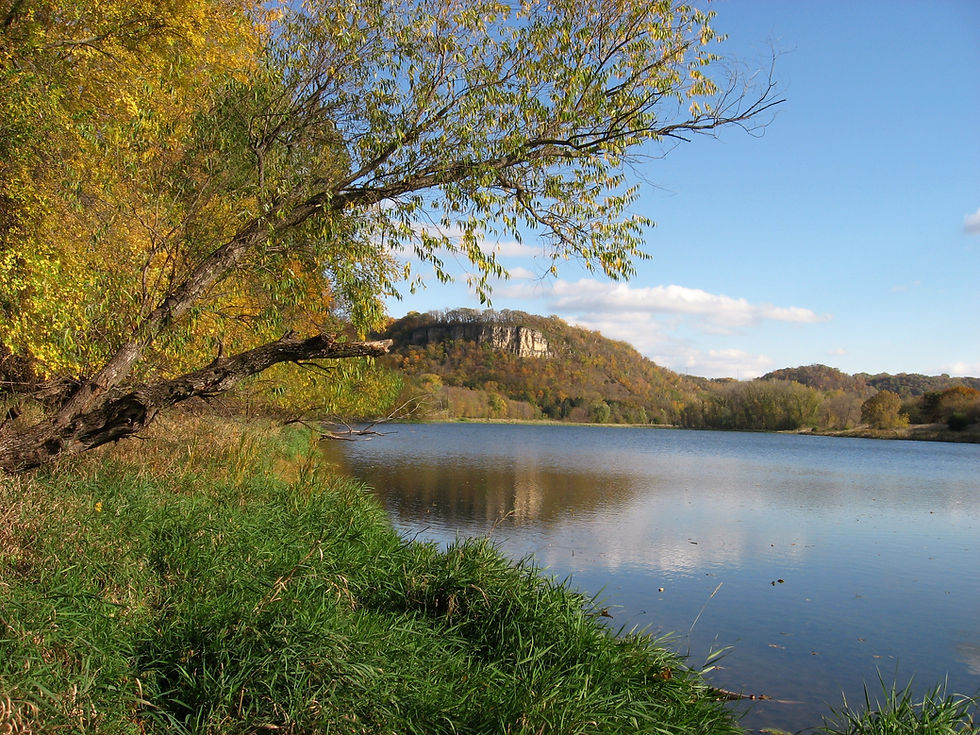Seasonal Bird Activity In Wacouta
- wacoutanaturenotes
- Oct 10
- 3 min read
Updated: Oct 11
As we move from summer into fall, we observe a whole host of interesting avian activities Some birds are preparing for migration while others have already started.

As mentioned in previous posts, pelican activity in the Wacouta area was greatly reduced by the lingering high water levels most of the summer.
However, with water levels dropping several feet in the past month, pelicans have returned to the area in large numbers.
For the past three weeks between two and three hundred birds can be observed on the lower end of lighthouse island across the river from Friedrich Point.

On the afternoon of September 24th. I paddled my solo canoe across the river to within 50 yards of the resting flock. If you look closely, several of the birds are busy preening themselves.

In front of the pelicans are a ring-necked gulls and one Caspian tern. The gulls prefer to roost and loaf in open areas with good visibility for spotting potential predators.
On many occasions the past few weeks, there have been large insect hatches out in the nearby prairie. These hatches attract large flocks of opportunistic gulls flying low over the prairie feeding on these insects.
Terns on the other hand fly gracefully with rowing wing beats over open water
of the river, diving to pick fish from just below the surface.

As the morning begins to warm up, it is quite common to observe pelicans circling high overhead in groups known as "kettles." By circling and moving in unison, they are taking advantage of thermal updrafts.
This behavior allows them to gain altitude and conserve energy, making long distance flights during migration much more efficient.

In the past three weeks, we have fielded several reports from our neighbors of ring-necked pheasant sightings in and above the prairie adjacent to Wacouta Road. These are the first Wacouta pheasant sightings in many years.
On many other occasions, I have heard the cackling call of the rooster. These calls can be heard up to 1 mile away and are used by the rooster to establish a territory. In full disclosure, this photo was taken in Frontenac State Park and not Wacouta.
This past spring and summer our yard was overrun by rabbits. In the past few weeks, there has been a remarkable decline in those sightings. At the same time, we have heard coyotes howling in close proximity to our house on nearly a nightly frequency.
I am puzzled to receive all the reports of pheasant observations at the same time the coyotes are here. If anyone has a theory on why the pheasants have been given a free pass in exchange of the predation of our rabbits, please let me know.

The last hummingbird to visit our nectar feeders was on October 3rd. The average departure date for these birds in southern Minnesota is September 25th.
The males started migrating at least 3 weeks ago followed a week later by the females. The last to leave are the young birds. This staggered departure schedule can serve as a protective strategy which reduces the risk of a catastrophic weather event wiping out large portions of the population.

On October 3rd, we observed our first White-throated sparrow as they migrate through our area after nesting in the forests of Canada. These birds are here just a short time as they head for their wintering grounds in the southern U.S.
These ground feeding birds are easy to identify from their white throat and crown. The bright yellow spot above the eye is also an identifying feature.
If you are lucky, you might hear their soft wavering whistle "oh-sweet- Canada." It is much more common to hear their singing in the spring than at this time of year. These ground feeding birds use both feet to scratch in the grass and leaf litter in search of insects and a variety of seeds.

On October 6th, we observed the arrival of the first Dark-eyed Juncos. They are sometimes referred to as "snowbirds." Large flocks of these birds arrive just in time to announce the first serious chance of snow flurries.
Juncos are also ground feeders and usually clean up fallen seeds from our feeders.
Frequent Nature Notes contributor Sue Milbright has passed along recent evidence of a local bobcat in our neighborhood on her Ring camera.




Again, I always learn something from your posts, Bruce. The bobcat sighting was very exciting since I've only seen 2 in my life in the wild. Thanks for always putting out such great information. Marty & Dud
A good reminder that the rhythm of nature continues, and we can enjoy it if we just stop to look. Thanks again Bruce your observations are a moment of calm in a busy world.